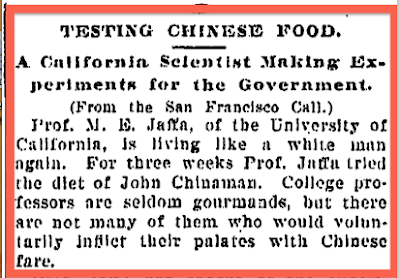Early Chinese immigrants worked long hours on farms, in laundries,
restaurants, and grocery stores, generally with meager amounts of food to eat. Observers were curious about the characteristics of the Chinese diet that enabled them to survive their long labors, and wanted to determine if it was a nutritious and
healthy fare.
In 1900,
Professor Myer E. Jaffa, a highly respected chemist who was the first professor of nutrition
at the University of California in Berkeley undertook a research study
to measure what a sample of 12 Chinese workers ate over 18 consecutive days.
A newspaper account of the research reported in the San Francisco Call began with derogatory insinuations about the palatability of Chinese food.
The study compared three groups of Chinese, professionals, laundrymen, and gardeners, based on the
extent of physical labor involved with their occupations, as noted by the
reporter.
The article summarized some of the findings but only after
first making light of one Chinese who was suspicious initially that the study was a
veiled attempt to tax him for the amount of food he ate. The reporter also described the types
of food that laborers ate as things that “sound strange to the Caucasian ear,
and taste stranger yet to his palate.”
The reported finished with Prof. Jaffa’s findings that the total
protein each day was low, as the Chinese had little meat and relied on a low-fat diet. He felt that their diet
had “an ample amount of nutrition.”
M. E. Jaffa, "Nutrition
Investigations Among Fruitarians and Chinese at the California Agricultural
Éxperiment Station, 1899-1901," U.S.D.A. Office
of Experiment Stations, Bulletin No. 107,
Washington, DC, 1901.






No comments:
Post a Comment